One-Step Microcrystalline Glass Preparation Using Smelting Slag from Waste Automobile Three-Way Catalysts through Iron Collection
Abstract
1. Introduction
2. Experiment
2.1. Experimental Materials and Equipment
2.2. Experimental Procedure
2.3. Analysis
3. Results and Discussion
3.1. Basic Glass Differential Thermal Analysis
3.2. Effects of Heat Treatment Temperature on the Crystal Precipitation of Microcrystalline Glass and Its Properties
3.3. Effect of Crystallization Time on Precrystallization and the Properties of the Microcrystalline Glass
3.4. Effects of Microcrystallization on the Toxic Leaching Characteristics of Heavy Metals
4. Conclusions
- (1)
- The differential thermal analysis of the base glass and the XRD analysis of the microcrystalline glass samples indicated that the main crystalline phase of the microcrystalline glass was constant and constituted by chalcocite feldspar. A suitable range of variables was determined. The crystallization temperature varied between 900 and 950 °C, and the crystallization time varied between 0.5 and 4 h.
- (2)
- Single-factor experiments were performed to analyze changes in the degree of crystallization, number of crystalline phases, grain shape, and physical and chemical properties of the microcrystalline glass, with crystallization temperature and time as variables. The optimal parameters for the heat treatment process were determined as follows: a crystallization temperature of 950 °C and a crystallization time of 3 h.
- (3)
- The physicochemical properties of the microcrystalline glass prepared with the proposed one-step method were determined: the bulk density was 2.72 g/cm3, the water absorption rate was 1.55%, the porosity was 4.2%, the Vickers hardness was 618 HV, the acid resistance was 2.6%, and the alkali resistance was 0.04%. The leaching concentrations of heavy metal ions were lower than those of the base glass and were considerably lower than the stipulated limits, and the harmful components were stabilized for disposal.
Author Contributions
Funding
Institutional Review Board Statement
Informed Consent Statement
Data Availability Statement
Acknowledgments
Conflicts of Interest
References
- Zhu, X.P.; Sun, S.C.; Tu, G.F.; Sun, T. Recovery of Palladium from Spent Catalyst by Trapping Molten Iron Powder. J. Northeast Univ. (Nat. Sci. Ed. ) 2020, 40, 1410–2834. [Google Scholar]
- Sun, J.; Ye, D.; Zou, J.; Chen, X.T.; Wang, Y.; Yuan, J.S.; Liang, H.W.; Qu, H.Q.; Binner, J.; Bai, J.M. A review on additive manufacturing of ceramic matrix composites. J. Mater. Sci. Technol. 2022, 138, 1–16. [Google Scholar] [CrossRef]
- Zhang, Y.X.; Liu, S.L.; OuYang, S.L.; Zhang, X.F.; Zhao, Z.W.; Jia, X.L.; Du, Y.S.; Deng, L.B.; Li, B.W. Transformation of unstable heavy metals in solid waste into stable state by the preparation of glass-ceramics. Mater. Chem. Phys. 2020, 252, 123061. [Google Scholar] [CrossRef]
- Cicek, B.; Tucci, A.; Bernardo, E.; Will, J.; Boccaccini, A.R. Development of glass-ceramics from boron containing waste and meat bone ash combinations with addition of waste glass. Ceram. Int. 2014, 40, 6045–6051. [Google Scholar] [CrossRef]
- Bai, Z.T.; Qiu, G.B.; Yue, C.S.; Guo, M.; Zhang, M. Crystallization kinetics of glass-ceramics prepared from high-carbon ferrochromium slag. Ceram. Int. 2016, 9, 102. [Google Scholar] [CrossRef]
- Liu, C. Study on Pyrometallurgical Recovery of Platinum from Spent Automotive Catalysts; Northeast University: Boston, MA, USA, 2018. [Google Scholar]
- Zou, W.T.; Zhang, W.H.; Pi, Y.L.; Zhang, Y.S.; Lei, Y.C. Study on preparation of glass-ceramics from multiple solid waste and coupling mechanism of heavy metals. Ceram. Int. 2022, 8, 173. [Google Scholar] [CrossRef]
- Angelidis, T.N.; Sklavounos, S.A. A SEM-EDS study of new and used automotive catalysts. Appl. Catal. A Gen. 1995, 133, 121–132. [Google Scholar] [CrossRef]
- Zheng, H.D.; Ding, Y.J.; He, X.F.; Shi, Z.S.; Jian, J.X.; Zhang, S.G. Study on Preparation of Glass Ceramics by One Step Method of Collecting Smelting Slag from Spent Automobile Catalyst Iron. Chin. J. Eng. 2022, 2, 1. [Google Scholar]
- Ma, J.; Shi, Y.; Zhang, H.X.; OuYang, S.L.; Deng, L.B.; Chen, H.; Zhao, M.; Du, Y.S. Crystallization of CaO–MgO–Al2O3–SiO2 glass ceramic derived from blast furnace slag via one-step method. Mater. Chem. Phys. 2020, 261, 124213. [Google Scholar] [CrossRef]
- Nan, N.; Cui, X.W.; Sun, Q.Q.; Zhao, W.; Wang, Z.Y.; Li, F.; He, B. Investigation on Preparation of Glass-ceramics with Iron Tailings. Compr. Min. Util. 2022, 43, 47–50. [Google Scholar]
- Wang, C.Y.; Jia, H.C.; Wang, A.P.; Wang, X.; Guo, Y.L.; Zhang, J.Y. Effect of TiO2 on the crystallization and properties of MgO-Al2O3-SiO2 glass-ceramics prepared by an “one-step| method from laterite ore. Ceram. Int. 2018, 10, 51. [Google Scholar] [CrossRef]
- Shi, J.; He, F.; Ye, C.Q.; Hu, L.; Xie, J.L.; Yang, H.; Liu, X.Q. Preparation and characterization of CaO–Al2O3 –SiO2 glass-ceramics from molybdenum tailings. Mater. Chem. Phys. 2017, 5, 28. [Google Scholar] [CrossRef]
- Rawlings, R.D.; Wu, J.P.; Boccaccini, A.R. Glass-ceramics: Their production from wastes: A Review. J. Mater. Sci. 2006, 41, 733–761. [Google Scholar] [CrossRef]
- Gao, H.T.; Liu, X.H.; Chen, J.Q.; Qi, J.L.; Wang, Y.B.; Ai, Z.R. Preparation of glass-ceramics with low density and high strength using blast furnace slag, glass fiber and water glass. Ceram. Int. 2018, 44, 6044–6053. [Google Scholar] [CrossRef]
- Karamanov, A.; Kamusheva, A.; Karashanova, D.; Ranguelov, B.; Avdeev, G. Structure of glass-ceramic from Fe-Ni wastes. Mater. Lett. 2018, 223, 86–89. [Google Scholar] [CrossRef]
- Zhao, S.Z.; Zhang, X.Y.; Liu, B.; Zhang, J.J.; Shen, H.L.; Zhang, S.G. Preparation of glass–ceramics from high-chlorine MSWI fly ash by one-step process. Rare Metals 2021, 40, 3316–3328. [Google Scholar] [CrossRef]
- Zhang, S.G.; Yang, J.; Liu, B.; Pan, D.A.; Wu, C.L.; Volinsky, A.A. One-step Crystallization Kinetic Parameters of the Glass-Ceramics Prepared from Stainless Steel Slag and Pickling Sludge. J. Iron Steel Res. Int. 2016, 23, 220–224. [Google Scholar] [CrossRef]
- Zhao, S.Z.; Liu, B.; Ding, Y.J.; Zhang, J.J.; Wen, Q.; Ekberg, C.; Zhang, S.G. Study on glass-ceramics made from MSWI fly ash, pickling sludge and waste glass by one-step process. J. Clean. Prod. 2020, 271, 122674. [Google Scholar] [CrossRef]
- Li, C.; Li, P.; Zhang, J.; Pei, F.; Gong, X.; Zhao, W.; Yan, B.; Guo, H. The Concurrent Sintering-Crystallization Behavior of Fluoride-Containing Wollastonite Glass-Ceramics. Materials 2021, 14, 681. [Google Scholar] [CrossRef]
- Luo, B.; Peng, T.; Sun, H.; Hui, T. Preparation and Crystallization of Magnetic Glass-Ceramics from the Residues after Sulfur Release and Iron Recovery from Copper Ore Tailings with Varied CaO Content. ChemistryOpen 2021, 10, 986–996. [Google Scholar] [CrossRef]
- Jo, S.; Kang, S. TiO2 effect on crystallization mechanism and physical properties of nano glass-ceramics of MgO-Al2O3-SiO2 glass system. J. Nanosci. Nanotechnol. 2013, 13, 3542–3545. [Google Scholar] [CrossRef]
- Liu, C.J.; Sun, L.F.; Wang, D.Y.; Jiang, M.F. Effect of comprehensive alkalinity on viscosity characteristics of continuous casting mold flux. J. Northeast. Univ. 2006, 7, 782–785. [Google Scholar]
- GB/T3810.3-2006; Test Methods of Ceramic Tiles Part 3: Determination of Water Absorption, Apparent Porosity, Apparent Relative Density and Bulk Density. National Standards of the People’s Republic of China: Beijing, China, 2006.
- Wang, K. Analysis and comparison of measurement methods of Rockwell hardness and Vickers hardness. Sci. Technol. Econ. Market. 2021, 16–17. [Google Scholar]
- US E P A. Toxicity Characteristic Leaching Procedure (TCLP), SW-846 Method 1311; US E P A: Washington, DC, USA, 1992; p. 55.
- Cao, C.; Peng, T.J.; Ding, W.J. Effect of crystallization temperature on crystallization and properties of CaO-Al2O3-SiO2-Fe2O3 fly ash glass ceramics. J. Chin. Ceram. Soc. 2013, 41, 122–128. [Google Scholar]
- Lv, J. Basic Research on Ecological Lead Smelting Technology of Waste Lead-Containing Electronic Glass; Northeastern University: Boston, MA, USA, 2019. [Google Scholar]
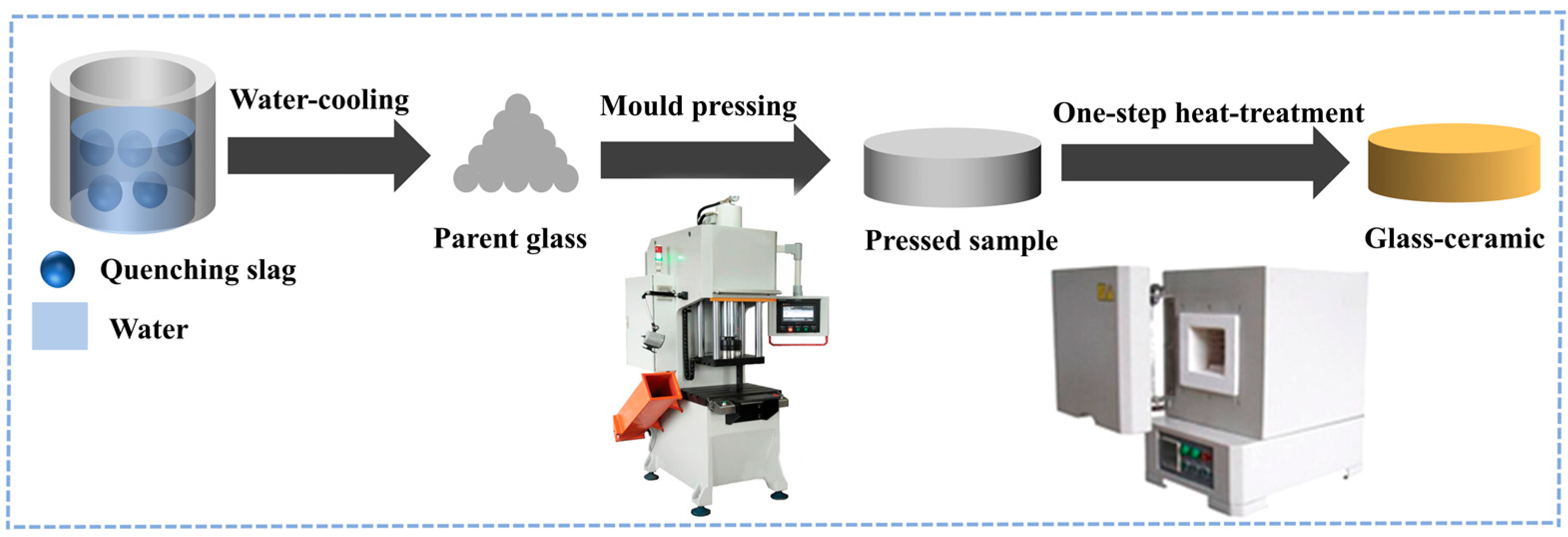
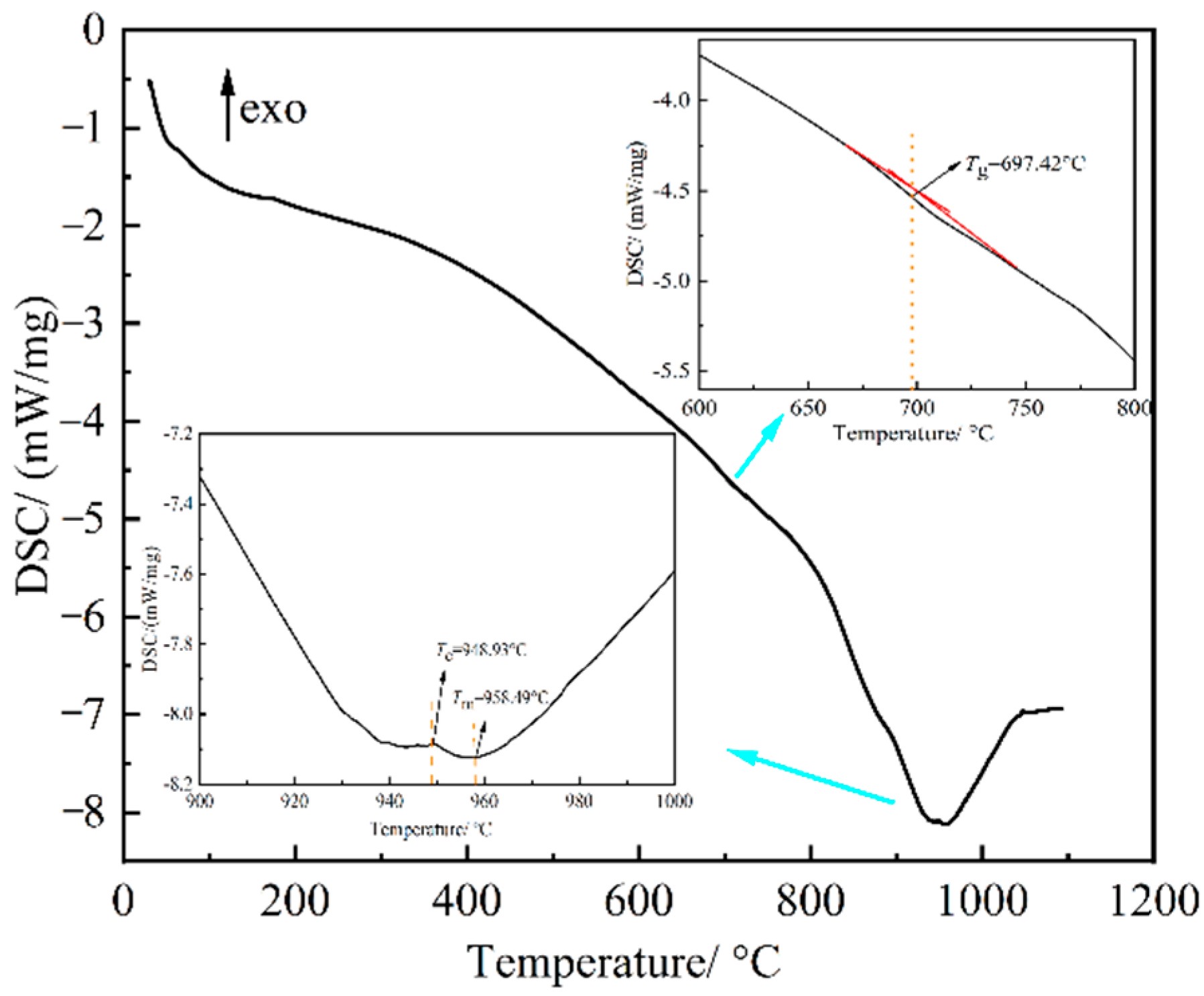


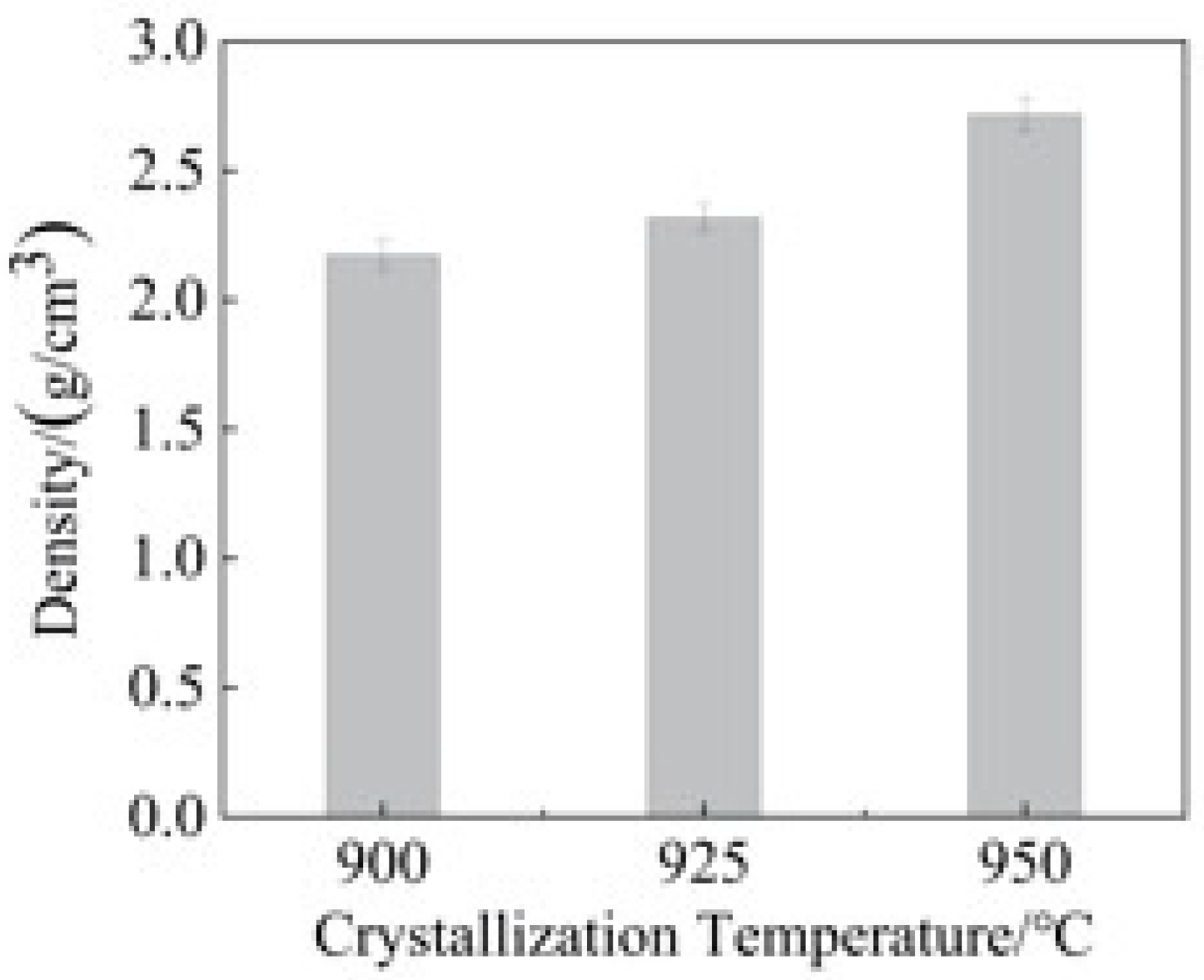
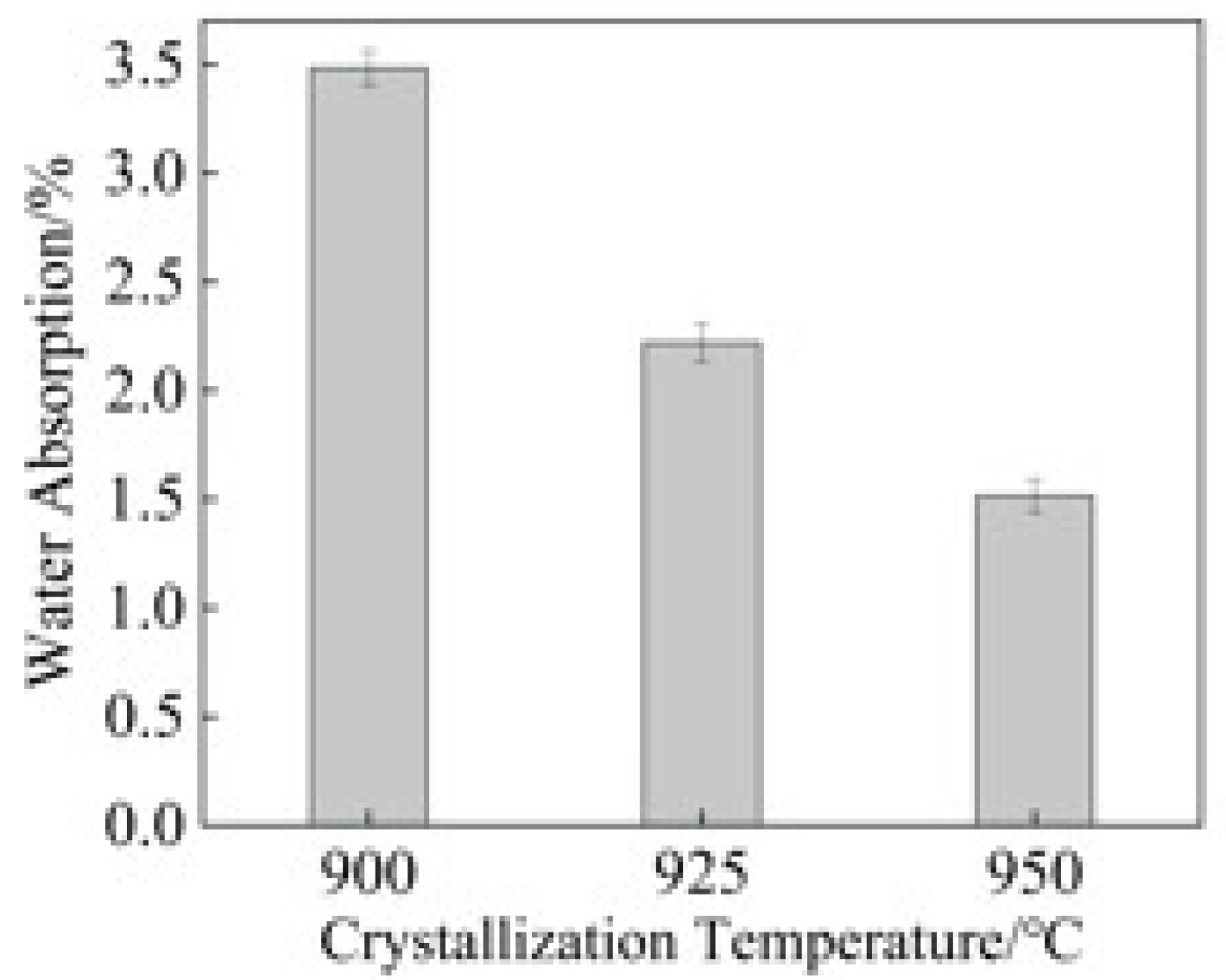
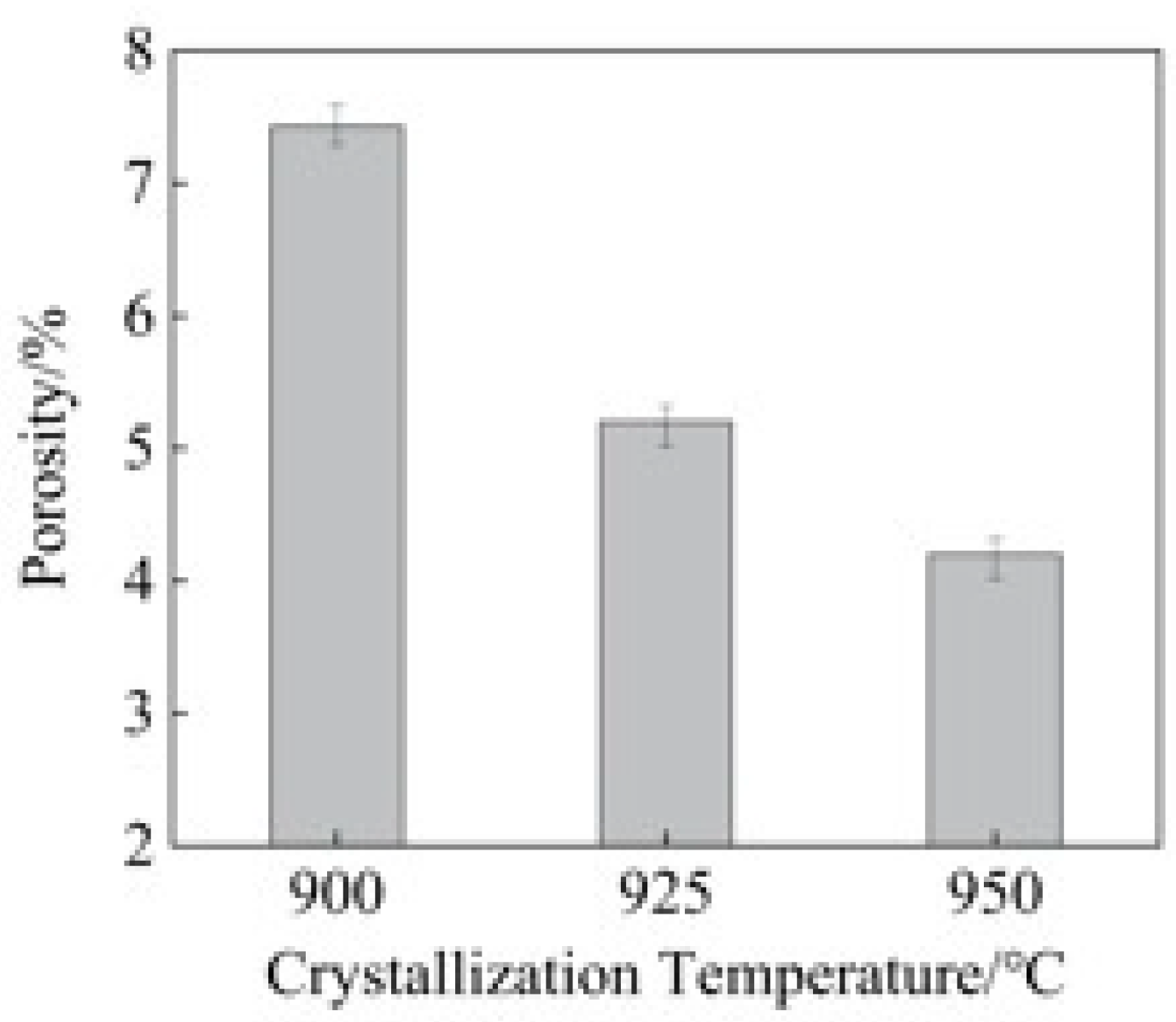

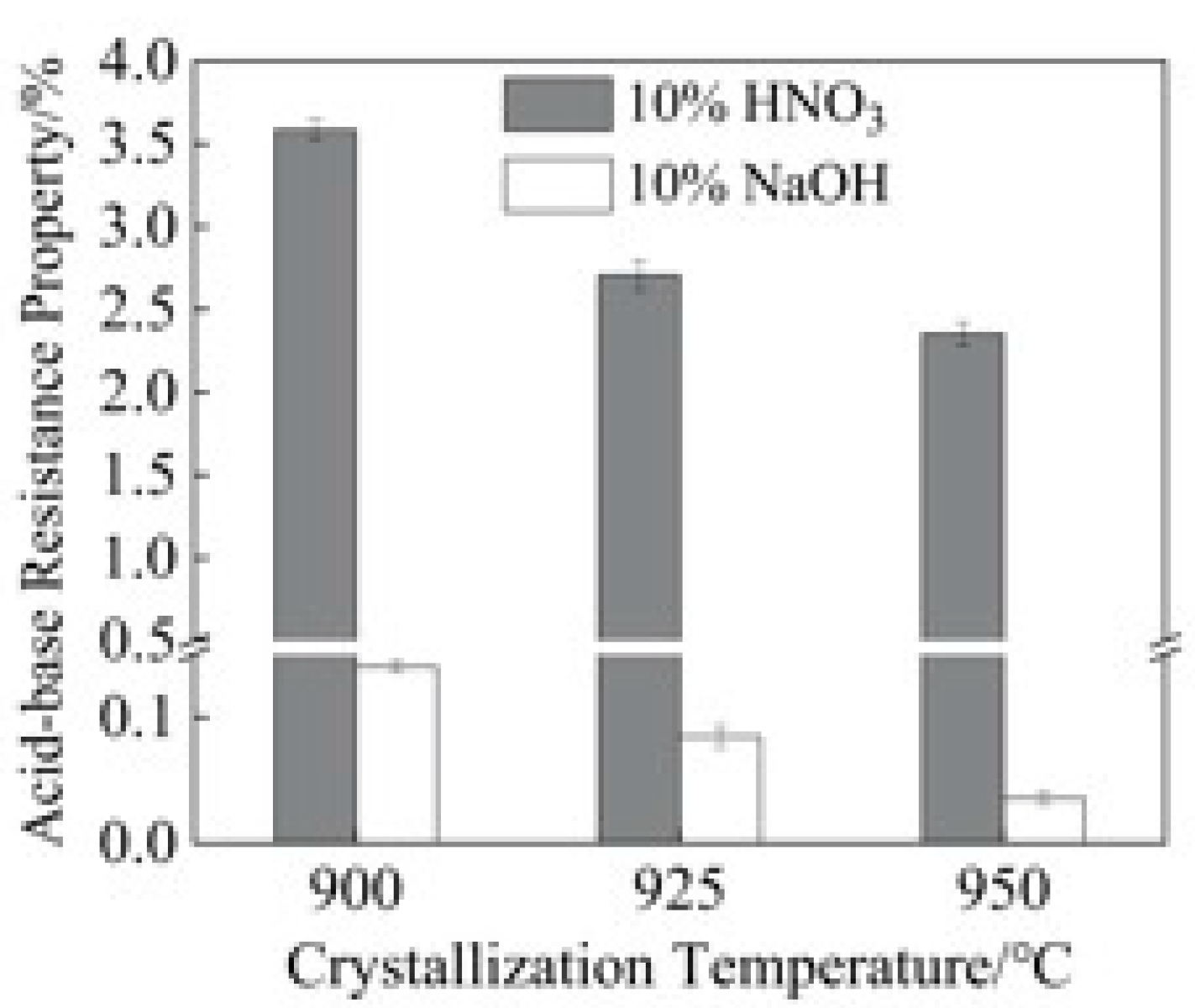
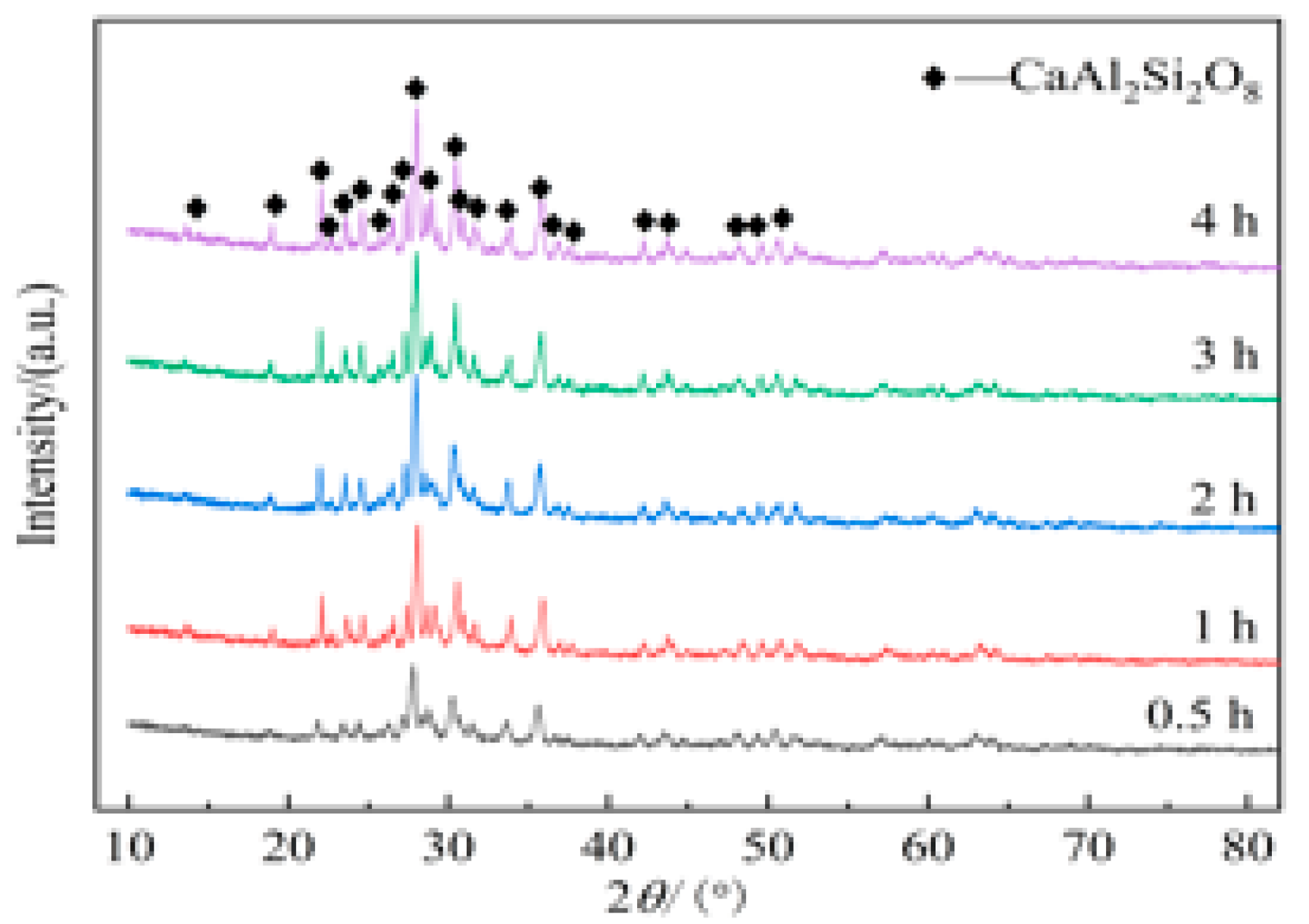


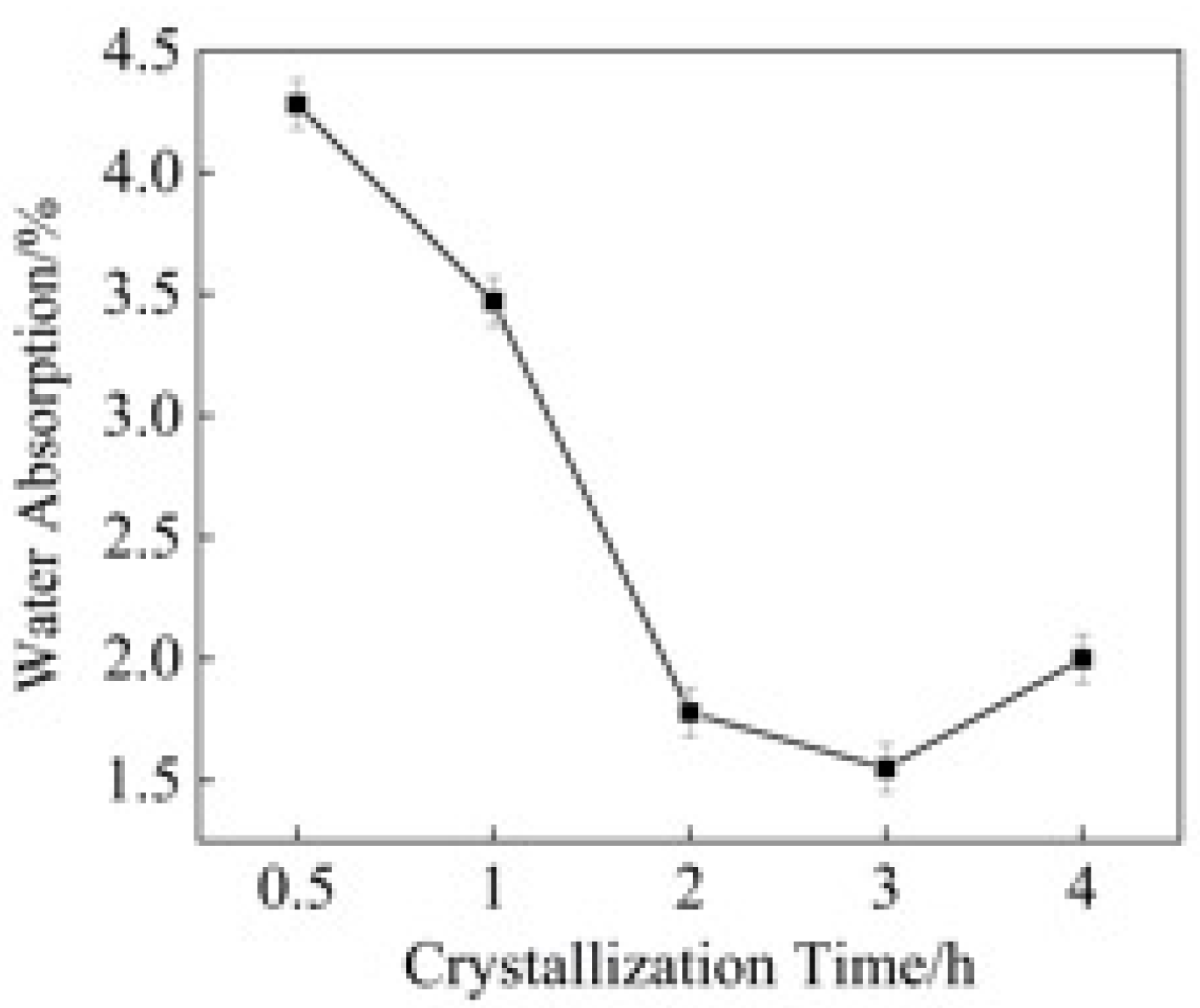
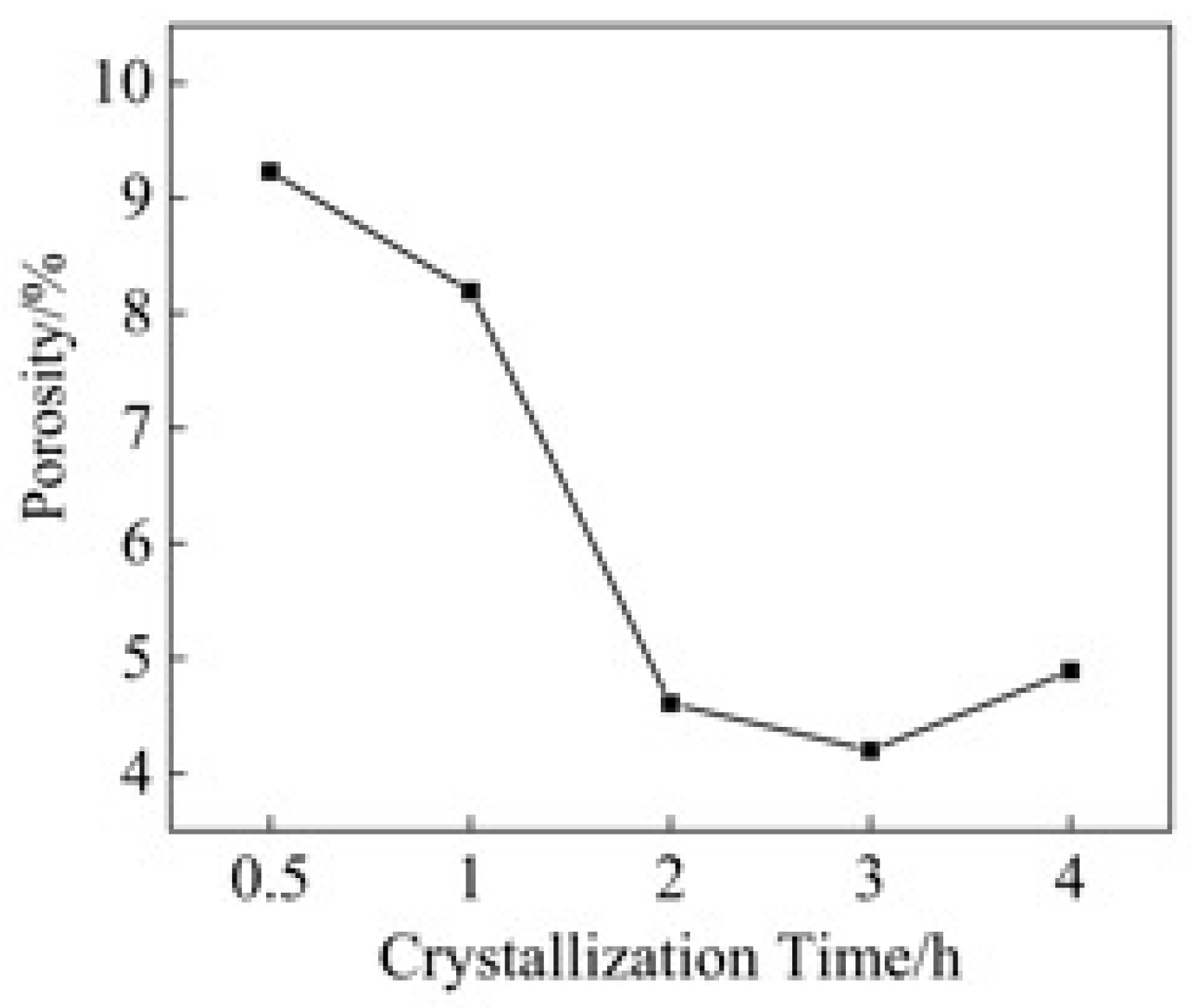


| Reagents | Specification | Manufacturers |
|---|---|---|
| sodium hydroxide | analytical grade | Sinopharm Chemical Reagent Co., Shanghai, China |
| nitric acid | analytical grade | Sinopharm Chemical Reagent Co. |
| acetic acid | analytical grade | Sinopharm Chemical Reagent Co. |
| hydrofluoric acid | C(HF) = 10% | Xiamen HaiBiao Technology Co. Xiamen, China |
| Apparatus Name | Specification/Model | Manufacturers |
|---|---|---|
| box resistance furnace | SX2-4-10 | Sinopharm Chemical Reagent Co. |
| temperature control instrument | CKW-3100 | Beijing Chaoyang Automatic Instrument Factory, Beijing, China |
| thermocouple | Platinum-Rhodium Couple(S type) | Shenyang Dongda Sensing Technology Co. Shenyang, China |
| constant-temperature drying oven | HG101-1A | Nanjing Experimental Instrument Factory, Beijing, China |
| differential thermal analyzer | SDTQ600 | Ta Corporation, Singapore |
| scanning electron microscope | SU-8010 | Hitachi, Japan |
| Vickers hardness tester | THVP-50 | Shenyang Times Testing Technology Co. Shenyang, China |
| X-ray diffractometer | D8 Advance | Bruker, Bremen, Germany |
| ICP plasma emission spectrometer | ICP-5000 | China Spotlight Technology Co., Beijing, China |
| Zn | Cr | Mn | Pb | |
|---|---|---|---|---|
| Base glass | 1 | 0.072 | 4.7 | BDL |
| Microcrystalline glass | 0.28 | BDL | 2.48 | BDL |
| Limit value | 500 | 5 | 5 | 5 |
Publisher’s Note: MDPI stays neutral with regard to jurisdictional claims in published maps and institutional affiliations. |
© 2022 by the authors. Licensee MDPI, Basel, Switzerland. This article is an open access article distributed under the terms and conditions of the Creative Commons Attribution (CC BY) license (https://creativecommons.org/licenses/by/4.0/).
Share and Cite
Zhu, X.; Huo, Y.; Zhao, R.; Wu, H.; Li, F.; Sun, S.; Liu, C. One-Step Microcrystalline Glass Preparation Using Smelting Slag from Waste Automobile Three-Way Catalysts through Iron Collection. Appl. Sci. 2022, 12, 11723. https://doi.org/10.3390/app122211723
Zhu X, Huo Y, Zhao R, Wu H, Li F, Sun S, Liu C. One-Step Microcrystalline Glass Preparation Using Smelting Slag from Waste Automobile Three-Way Catalysts through Iron Collection. Applied Sciences. 2022; 12(22):11723. https://doi.org/10.3390/app122211723
Chicago/Turabian StyleZhu, Xiaoping, Yingda Huo, Ruiming Zhao, Hao Wu, Fubao Li, Shuchen Sun, and Chuan Liu. 2022. "One-Step Microcrystalline Glass Preparation Using Smelting Slag from Waste Automobile Three-Way Catalysts through Iron Collection" Applied Sciences 12, no. 22: 11723. https://doi.org/10.3390/app122211723
APA StyleZhu, X., Huo, Y., Zhao, R., Wu, H., Li, F., Sun, S., & Liu, C. (2022). One-Step Microcrystalline Glass Preparation Using Smelting Slag from Waste Automobile Three-Way Catalysts through Iron Collection. Applied Sciences, 12(22), 11723. https://doi.org/10.3390/app122211723





